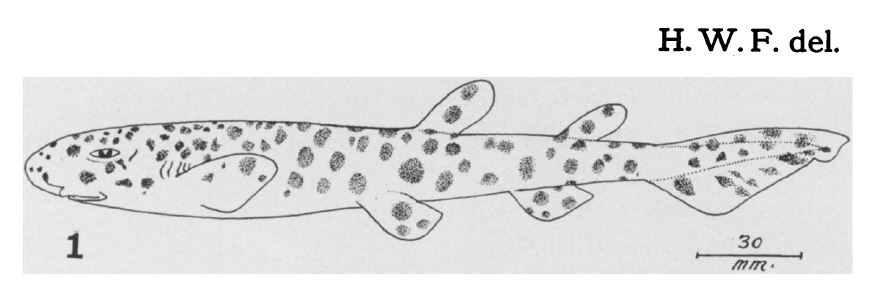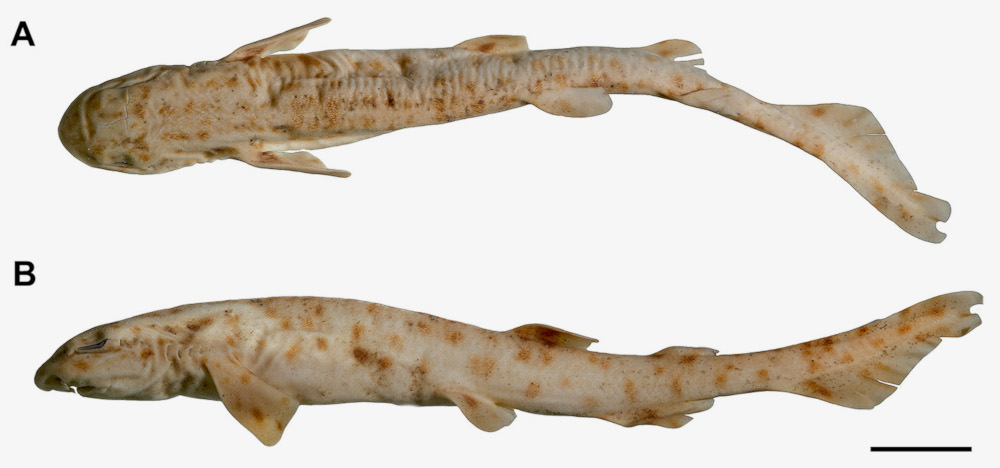Scyliorhinus garmani
(Fowler, 1934)
Brownspotted catshark
Classification: Elasmobranchii Carcharhiniformes Scyliorhinidae
Reference of the original description
Descriptions of new fishes obtained 1907 to 1910, chiefly in the Philippine Islands and adjacent seas. Proceedings of the Academy of Natural Sciences of Philadelphia, 85, 233–367
Descriptions of new fishes obtained 1907 to 1910, chiefly in the Philippine Islands and adjacent seas. Proceedings of the Academy of Natural Sciences of Philadelphia, 85, 233–367
Image of the original description

Halaelurus garmani Fowler, 1934 valid as Scyliorhinus garmani (Fowler, 1934)

Halaelurus garmani Fowler, 1934 valid as Scyliorhinus garmani (Fowler, 1934)
Synonyms / new combinations and misspellings
Halaelurus garmani
Halaelurus garmani
Description :
Citation: Scyliorhinus garmani (Fowler, 1934): In: Database of modern sharks, rays and chimaeras, www.shark-references.com, World Wide Web electronic publication, Version 12/2025
Please send your images of "Scyliorhinus garmani" to info@shark-references.com

Scyliorhinus garmani (Fowler, 1934), holotype, USNM 43749, female, 267.2 mm TL ("East Indies", probably Philippines). A, dorsal view; B, lateral view. Scale bar = 20 mm. © Karla A. Soares, Laboratório de Ictiologia, Departamento de Zoologia, Instituto de Biociências, Universidade de São Paulo

Scyliorhinus garmani (Fowler, 1934), holotype, USNM 43749, female, 267.2 mm TL ("East Indies", probably Philippines). A, dorsal view; B, lateral view. Scale bar = 20 mm. © Karla A. Soares, Laboratório de Ictiologia, Departamento de Zoologia, Instituto de Biociências, Universidade de São Paulo
Common names
 Alitán manchado,
Alitán manchado,  Roussette à taches brunes,
Roussette à taches brunes,  Brown-spotted cat shark,
Brown-spotted cat shark,  Brownspotted catshark
Brownspotted catshark
 Alitán manchado,
Alitán manchado,  Roussette à taches brunes,
Roussette à taches brunes,  Brown-spotted cat shark,
Brown-spotted cat shark,  Brownspotted catshark
Brownspotted catshark
Short Description
Diagnosis after Compagno, 1984 [517]: Field Marks : A stocky catshark with large round brown spots scattered on body, indistinct saddle markings, no white spots, anterior nasal flaps not reaching mouth, no nasoral grooves, labial furrows on lower jaw only, second dorsal fin much smaller than first. Diagnostic Features: Body relatively stout but head deep and narrow. Greatest width of head less than 2/3 of head length; no nasoral grooves; anterior nasal flaps moderately expanded medially and posteriorly, well separated medially but extending to the mouth. First dorsal origin about opposite pelvic insertions; second dorsal origin over last third of pelvic bases; interdorsal space somewhat greater than anal base. Denticles rather large and erect crowned, skin fairly rough. Colour pattern of large scattered brown spots as large or larger than eye pupil; 7 dusky saddle marks obscure or obsolete; no white spots. Adult size unknown, maximum size over 24 to 36 cm.
Diagnosis after Compagno, 1984 [517]: Field Marks : A stocky catshark with large round brown spots scattered on body, indistinct saddle markings, no white spots, anterior nasal flaps not reaching mouth, no nasoral grooves, labial furrows on lower jaw only, second dorsal fin much smaller than first. Diagnostic Features: Body relatively stout but head deep and narrow. Greatest width of head less than 2/3 of head length; no nasoral grooves; anterior nasal flaps moderately expanded medially and posteriorly, well separated medially but extending to the mouth. First dorsal origin about opposite pelvic insertions; second dorsal origin over last third of pelvic bases; interdorsal space somewhat greater than anal base. Denticles rather large and erect crowned, skin fairly rough. Colour pattern of large scattered brown spots as large or larger than eye pupil; 7 dusky saddle marks obscure or obsolete; no white spots. Adult size unknown, maximum size over 24 to 36 cm.
Distribution
Indo-West Pacific: known from the indefinite type locality ("quot;East Indies"quot; = Indonesia) and Dumaguete, Philippines. Source: www.gbif.org
Indo-West Pacific: known from the indefinite type locality ("quot;East Indies"quot; = Indonesia) and Dumaguete, Philippines. Source: www.gbif.org
Human uses
fisheries: of no interest
fisheries: of no interest
Habitat
benthopelagic; marine
benthopelagic; marine
Dentition
Monognathic heterodonty gradual well developed; anterior teeth abruptly larger than the parasymphysial ones and lateral teeth smaller distally, with smaller and thicker principal cusps. Tooth counts 22–24/22–1–22. Upper teeth with slightly higher principal cusps than lower ones, and striae longer and stouter. Parasymphysial and anterior teeth similar in shape and principal cusp straight; one cusplet on each side of the principal cusp. Lateral teeth with principal cusp slightly oblique and one cusplet at each side. Commissural teeth not examined. [27296]
Monognathic heterodonty gradual well developed; anterior teeth abruptly larger than the parasymphysial ones and lateral teeth smaller distally, with smaller and thicker principal cusps. Tooth counts 22–24/22–1–22. Upper teeth with slightly higher principal cusps than lower ones, and striae longer and stouter. Parasymphysial and anterior teeth similar in shape and principal cusp straight; one cusplet on each side of the principal cusp. Lateral teeth with principal cusp slightly oblique and one cusplet at each side. Commissural teeth not examined. [27296]
Remarks
shark-references Species-ID=6319;
shark-references Species-ID=6319;


















